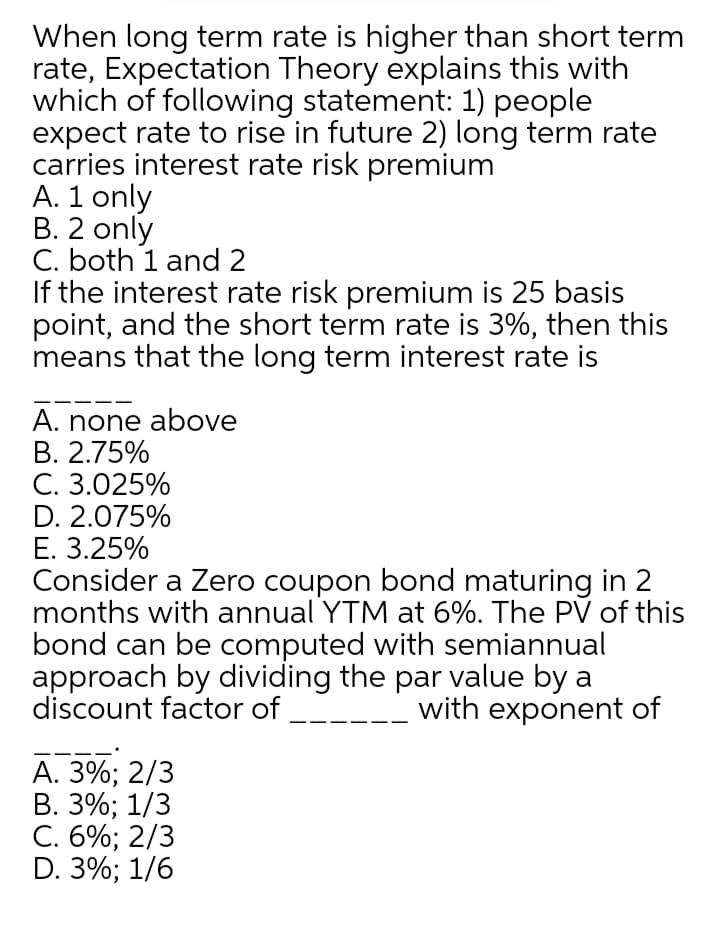When long term rate is higher than short term rate, Expectation Theory explains this with which of following statement: 1) people expect rate to rise in future 2) long term rate carries interest rate risk premium A. 1 only B. 2 only C. both 1 and 2 If the interest rate risk premium is 25 basis point, and the short term rate is 3%, then this means that the long term interest rate is A. none above B. 2.75% C. 3.025% D. 2.075% E. 3.25% Consider a Zero coupon bond maturing in 2 months with annual YTM at 6%. The PV of this bond can be computed with semiannual approach by dividing the par value by a discount factor of with exponent of А. 3%;B 2/3 В. 3%;B 1/3 C. 6%; 2/3 D. 3%; 1/6
When long term rate is higher than short term rate, Expectation Theory explains this with which of following statement: 1) people expect rate to rise in future 2) long term rate carries interest rate risk premium A. 1 only B. 2 only C. both 1 and 2 If the interest rate risk premium is 25 basis point, and the short term rate is 3%, then this means that the long term interest rate is A. none above B. 2.75% C. 3.025% D. 2.075% E. 3.25% Consider a Zero coupon bond maturing in 2 months with annual YTM at 6%. The PV of this bond can be computed with semiannual approach by dividing the par value by a discount factor of with exponent of А. 3%;B 2/3 В. 3%;B 1/3 C. 6%; 2/3 D. 3%; 1/6
Chapter8: Analysis Of Risk And Return
Section: Chapter Questions
Problem 26P
Related questions
Question
f3

Transcribed Image Text:When long term rate is higher than short term
rate, Expectation Theory explains this with
which of following statement: 1) people
expect rate to rise in future 2) long term rate
carries interest rate risk premium
A. 1 only
B. 2 only
C. both 1 and 2
If the interest rate risk premium is 25 basis
point, and the short term rate is 3%, then this
means that the long term interest rate is
A. none above
В. 2.75%
C. 3.025%
D. 2.075%
E. 3.25%
Consider a Zero coupon bond maturing in 2
months with annual YTM at 6%. The PV of this
bond can be computed with semiannual
approach by dividing the par value by a
discount factor of
with exponent of
А. 3%; 2/3
В. 3%;B 1/3
С. 6%;B 2/3
D. 3%; 1/6
Expert Solution
This question has been solved!
Explore an expertly crafted, step-by-step solution for a thorough understanding of key concepts.
Step by step
Solved in 2 steps

Knowledge Booster
Learn more about
Need a deep-dive on the concept behind this application? Look no further. Learn more about this topic, finance and related others by exploring similar questions and additional content below.Recommended textbooks for you

EBK CONTEMPORARY FINANCIAL MANAGEMENT
Finance
ISBN:
9781337514835
Author:
MOYER
Publisher:
CENGAGE LEARNING - CONSIGNMENT

EBK CONTEMPORARY FINANCIAL MANAGEMENT
Finance
ISBN:
9781337514835
Author:
MOYER
Publisher:
CENGAGE LEARNING - CONSIGNMENT